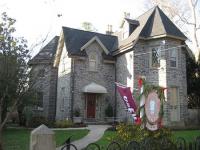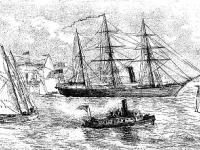Archival Adventures in Small Repositories
Archival Adventures in Small Repositories

Wheat, Rye, Corn, Mix, Oats, or Corn Cobs? I know those options sounds delicious, but no, I'm not asking what you want for lunch. At a grist mill in the late 19th and early 20th centuries this would have been a familiar question. There used to be scores of mills, including about 20 grist mills, lining the banks of the Wissahickon Creek. Today, the Evans-Mumbower Mill is one of only a few that remain.
Like several of today’s suburbs outside of Philadelphia, Wallace Township (Chester County) used to be home to many farmsteads in the 18th and early 19th centuries. However, by the late 19th century, the railroad had made its way to these rural communities, bringing with it an influx of Philadelphians eager to establish summer residences away from the city. Among these Philadelphians were the Howsons.
The area now known as Uwchlan Township, Chester County, Pennsylvania was once occupied by the Leni-Lenape (Delaware) and Iroquoian-speaking Susquehanuck peoples, and many of the footpaths they created are still in use today as roads that crisscross through the Township. Welsh Quakers were the main European group to settle in Uwchlan, requesting their own meeting in 1712.
For decades, Stinson Markley's land in Charlestown Township, Chester County, Pennsylvania was used to cultivate fruits, vegetables, and even wild turkeys. The Markley farm is now owned by the Charlestown Historical Society, which is sown with carefully tended archival documents, the information contained therein ripe for reaping by historians and other researchers!
The Tredyffrin Easttown Historical Society has a variety of materials documenting the long and rich history of these two Main Line townships and their residents. The collections include subject files, maps, numerous photographs, family albums, manuscripts and other items helpful for research.
"The father of gospel music," African American minister Charles A. Tindley (1851-1933) grew his Philadelphia church into one of the largest Methodist congregations in the United States in the 1920s. Tindley, the man and his church, are the topic of this week's blog post, continuing our Black History Month mini-series from last week. The Charles A. Tindley Institute (CATI), located at Tindley Temple United Methodist Church, is dedicated to telling the story of Tindley's life and legacy.
Tell all your friends! February is Black History Month, and one of the best places to study Black history in this city is at the African American Museum in Philadelphia (AAMP). One of the largest and most robust archival repositories we have visited thus far, AAMP's collections document African Americans active in the arts, medicine, politics, sports, and many other arenas. In this blog I will highlight just a few of my favorite AAMP collections.
Last fall HCI-PSAR facilitated a pilot internship program that paired emerging archivists in need of hands-on experience with small repositories in need of processing assistance and large repositories willing to train and supervise the intern. We matched intern Tracy Ulmer with the Chestnut Hill Historical Society and Drexel University College of Medicine Archives & Special Collections. Tracy reflected on the Jessie Laird Brodie, M.D. papers, the Philadelphia Canoe Club records, and her other experiences in the blog below.
Last fall HCI-PSAR facilitated a pilot internship program that paired emerging archivists in need of hands-on experience with small repositories in need of processing assistance and large repositories willing to train and supervise the intern. One of our interns, Sarah Leu, has just written a blog post about her experience! We matched Sarah with the Margaret R. Grundy Memorial Library and the Historical Society of Pennsylvania.
Before embarking on the HCI-PSAR project, I had no idea how many signficant world explorers called the Philadelphia area home. On a recent visit to the Sharon Hill Historical Society (Delaware County, Pa.), I learned about Arctic explorer George W. Melville (1841-1912). He joins the ranks of William Edgar Geil, the Doylestown native who walked the entire length of the Great Wall of China and visited parts of Africa and Oceania around the turn of the 19th century. Melville was also a naval engineer, like John Ericsson, whose papers we surveyed at the American Swedish Historical Museum.
- ‹ previous
- 8 of 21
- next ›
Image Permissions
Unless otherwise noted, all images in this blog post are property of the organization profiled, not the Historical Society of Pennsylvania. To reproduce any image or obtain a higher quality version, please contact the organization directly.










